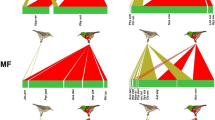Summary
The lizard genus Cnemidophorus (family Teiidae) contains sexual as well as parthenogenetic species. The theoretical two-fold fitness advantage of asexuality does not translate into any obvious distributional or numerical superiority of the parthenogenic species in the southwestern US and northern Mexico where their ranges overlap. I tested the prediction that the genetically diverse sexual species should have a higher between-individual niche width than a similar sympatric asexual species by studying the prey in stomach contents of sympatric and allopatric populations of C. tigris (sexual) and C. sonorae (asexual) in southern Arizona. The expectation proved true for niche breadths based on both prey length and prey taxa categories. The within-individual component of niche breadth was not different between species. Meaningful comparisons between species in sympatry and allopatry are confounded by the uncontrolled differences in the availability and diversity of food items between sites. Before the generality of these results can be assessed the study should be repeated in other areas where sexual and asexual species are syntopic and of similar body size.
Similar content being viewed by others
References
Bell G (1982) The masterpiece of nature: the evolution and genetics of sexuality. University of California Press, Berkeley
Brown WM, Wright JW (1979) Mitochondrial DNA analyses and the origin and relative age of parthenogenetic lizards (Genus Cnemidophorus). Science 203:1247–1249
Case TJ (1975) Species number, density compensation and colonizing ability of lizards on islands in the Gulf of California. Ecology 56:3–18
Case TJ (1979) Character displacement and coevolution in some Cnemidophorus lizards. Fortschr Zool 24:235–282
Case TJ (1983) Size-similarity and sympatry in Cnemidophorus lizards. Ch. 14 In: Huey R, Schoener T, Pianka E (eds) Lizard Ecology. Harvard University Press, Cambridge, Mass, pp 297–325
Case TJ, Bender EA (1981) Is recombination advantageous in fluctuating and spatially heterogeneous environments? J Theor Biol 90:181–190
Case TJ, Taper ML (1986) On the coexistence of asexual and sexual species. Evolution 40:366–387
Charlesworth B (1971) Selection in density regulated populations. Ecology 52:469–474
Cuellar O (1971) Reproduction and mechanism of meiotic restitution in the parthenogenetic lizard, Cnemidophorus uniparens. J Morphol 133:139–165
Cucllar O (1976) Intraclonal histocompatibility in a parthenogenetic lizard: evidence of genetic homogeneity. Science 193:150–153
Cuellar O (1977) Animal parthenogenesis. Science 197:837–843
Dessauer HC, Cole CJ (1989) Diversity between and within nominal forms of unisexual teiid lizards. In: Dawley RM, Bogard JP (eds) Evolution and ecology of unisexual vertebrates. New York State Museum, Albany, NY, pp 49–71
Densmore LD, Moritz CC, Wright JW, Brown WM (1989) Motochondrial-DNA analyses and the origin and relative age of parthenogenetic lizards (genus Cnemidophorus). IV. Nive sexlineatus-group unisexuals. Evolution 43:969–983
Echternacht AC (1967) Ecolocal relationships of two species of the lizard genus Cnemidophorus in the Santa Rita Mountains of Arizona. Am Midl Nat 78:448–459
Heckel DG, Roughgarden J (1979) A technique for estimating the size of lizard populations Ecology 60:966–975
Levins R (1968) Evolution in changing environments. Princeton University Press, Princeton, NJ
Lowe CH, Wright JW (1964) Species of the Cnemidophorus exsanguis subgroup of whiptail lizards. J Ariz Acad Sci 3:78–80
Maslin TP (1968) Taxonomic problems in parthenogenetic vertebrates. Zoologica 17:219–231
Maynard-Smith J (1978) The evolution of sex. Cambridge University Press, Cambridge, Mass.
Medica PA (1967) Food habits, habitat preference, reproduction, and diurnal activity in four sympatric species of whiptail lizards (Cnemidophorus) in South Central New Mexico. Bull S Calif Acad Sci 66:251–276
Mitchell JC (1979) Ecology of southeastern Arizona whiptail lizards (Cnemidophorus: Teiidae): population densities, resource partitioning, and niche overlap. Can J Zool 57:1487–1499
Neaves WB (1969) Adenosine deaminase phenotypes among sexual and parthenogenetic lizards in the Genus Cnemidophorus (Teiidae). J Exp Zool 171:175–184
Parker ED (1979a) Phenotypic consequences of parthenogenesis in Cnemidophorus lizards. I. Relative variability in parthenogenetic and sexual populations. Evolution 33:1150–1166
Parker ED (1979b) Phenotypic consequences of parthenogenesis in Cnemidophorus lizards. II. Similarity of C. tesselatus to its sexual parental species. Evolution 33:1167–1179
Parker ED, Selander RK (1976) The organization of genetic diversity in the parthenogenetic lizard Cnemidophorus tesselatus. Genetics 84:791–805
Pimm SL (1983) Appendix: Monto Carlo analyses in ecology. In: Huey R, Schoener T, Pianka E (eds) Lizard ecology. Harvard University Press, Cambridge, Mass, pp 290–296
Ryti RL, Case TJ (1986) Spatial arrangement and diet overlap between colonies of desert ants. Oecologia 62:401–404
Schall JJ (1976) Comparative ecology of sympatric parthenogenetic and bisexual species of Cnemidophorus. Ph.D. Dissertation. Univ. of Texas, Austin
Schenck RA, Vrijenhoek RC (1986) Spatial and temporal factors affecting the coexistence among sexual and clonal forms of Poeciliopsis. Evolution 40:1060–1070
Schoener T (1974) Resource partitioning in ecological communities. Science 185:27–39
Scudday JF, Dixon JR (1973) Diet and feeding behavior of teiid lizards from Trans-Pecos, Texas. Southwest Nat 18:279–289
Simpson EH (1949) Measurement of diversity. Nature 163:688
Uzzell TM (1970) Meiotic mechanisms of naturally occurring unisexual vertebrates. Am Nat 104:433–445
White MJD (1970) Heterozygosity and genetic polymorphism in parthenogenetic animals. In: Hecht MR, Steere VC (eds) Essays in evolutions and genetics in honor of Theodosius Dobzhansky. Appleton-Century-Crofts, New York, pp 237–262
White MJD (1978) Modes of Speciation. WH Freeman, San Francisco
Williams GC (1975) Sex and evolution. Princeton University Press, Princeton
Wright JW (1968) Variation in three sympatric sibling species of whiptail lizards, genus Cnemidophorus. J Herpetol 1:1–19
Wright JW, Lowe CH (1968) Weeds, polyploids, parthenogenesis and the geographical and ecological distribution of all-female species of Cnemidophorus. Copeia 1968:129–138
Zar HH (1984) Biostatistical analysis, 2nd edn. Prentice-Hall, Englewood Cliffs, NJ
Zweifel RG (1965) Variation in and distribution of the unisexual lizard, Cnemidophorus tesselatus. Am Mus Novit 2235:1–49
Author information
Authors and Affiliations
Rights and permissions
About this article
Cite this article
Case, T.J. Patterns of coexistence in sexual and asexual species of Cnemidophorus lizards. Oecologia 83, 220–227 (1990). https://doi.org/10.1007/BF00317756
Received:
Accepted:
Issue Date:
DOI: https://doi.org/10.1007/BF00317756




